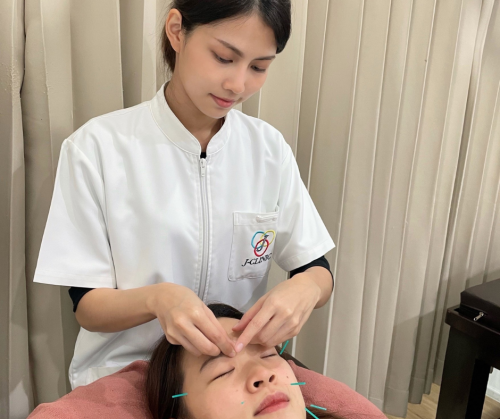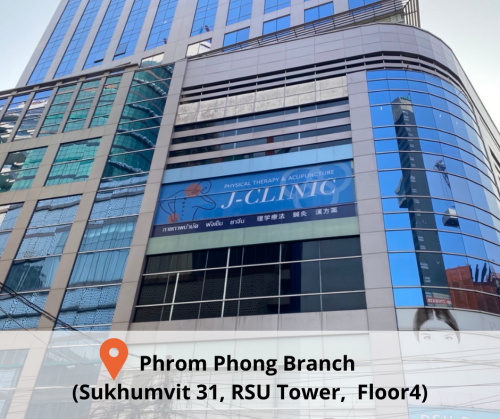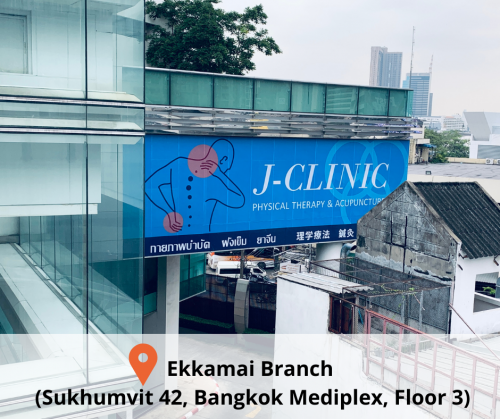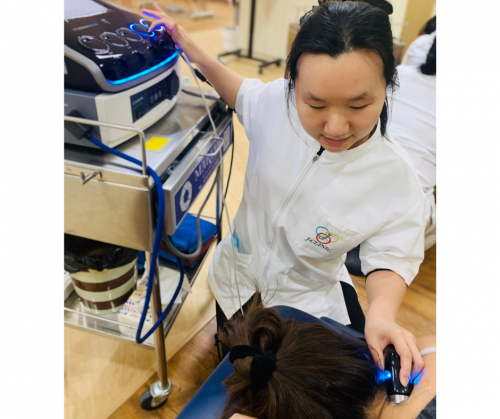Hello, my name is Sato and I run J-CLINIC, a physiotherapy and acupuncture clinic in Bangkok.
Do you ever work on a computer all day at the office, only to watch YouTube late at night at home with blurred eyes, stiff neck and shoulders, and headaches?
What is VDT syndrome?

The group of physical and mental health problems caused by prolonged use of visual display terminals—i.e., smartphones, tablets, computers, and TVs—is called “visual display terminal (VDT) syndrome.”

In the past, people suffered from shoulder and neck pain caused by so-called office syndrome. But changes in modern lifestyle means that now more people are experiencing body and eye problems from visual display terminal syndrome.
Symptoms of VDT syndrome
Common symptoms of VDT syndrome include the following:
- Eyestrain
Hyperemia (red eye) and pain, eyestrain, eyelid cramps, decreased vision, dry eyes, etc.
- Body pain
Stiff neck and shoulders, fatigue. When these symptoms become chronic, they can lead to more serious conditions such as numbness in the fingers and the whole body.
- Emotional effects
Tiredness, irritation, depressive symptoms, insomnia, lethargy, etc.
In particular, if you use your smartphone for a long time with improper postures—such as lying on your belly—the muscles around the neck become strained.

Here’s how J-CLINIC can treat VDT syndrome.
If you feel pain at the back or side of your head or at the back of your eyes, it may be because the shoulder blade or back is stiff. If that is the case, we’ll also show you exercises and stretches to prevent your body from becoming stiff.
- Facial acupuncture

An extra-thin acupuncture needle is placed into the muscles around the eyes to relax tension and promote recovery from fatigue. Waste materials are then flushed out with Gua sha massage.
Watch our facial acupuncture course
It’s said that VDT syndrome is caused when you use visual display terminals while staying in the same posture and condition.

Even when you know that using a smartphone, tablet or computer for a long time is not good, in reality, it can be hard to avoid it. So let’s minimize the harm while keeping our bodies and eyes in good repair.
If you suffer from VDT syndrome in Bangkok, get in touch with us by phone, email or Facebook.
📞For Booking
- Phrom Phong: 097-257-3577
- Thonglor: 084-424-1299
- Ekkamai: 097-245-7863
Treatments for shoulder pains
- Shoulder muscle sprain
- Shoulder rotator cuff injuries
- Biceps tendinitis
- shoulder impingement syndrome
- Shoulder tendonitis
Past cases
- Physical therapy for ballet dancers
- Common problems for ballet dancers: Hip and knee joint pain
- Sprained playing soccer! Ligament damage
- What causes herniated discs and back pain?
- Post-surgery rehabilitation at J-CLINIC
- Treating sciatica
- Treating frozen shoulder
- Physical therapy for kendo practitioners
- Treating weight-training injuries
- Your stiff shoulders and headaches are caused by uneven shoulder blades?
What physical pains can be treated at J-CLINIC?
- Physical therapylower back pain, stiff shoulders, sciatica, headaches, knee pain, sprains, pulled muscles, whiplash, post-fracture rehabilitation and injuries from sports and accidents.
- Acupuncture treatmentPMS, irregular periods, insomnia, orthopedic diseases, headache, cosmetic acupuncture, eye strain, gastrointestinal problems.
Our branches in Sukhumvit road
- Phrom Phong Branch (Sukhumvit 31, RSU Tower Floor4)

From BTS Phrom Phong Station, take Exit 5 and walk along Sukhumvit towards Asoke for about 5 minutes. RSU Tower will be on your right. Take the escalator up to Floor 4 and you will see us right in front of you. If you are coming by car, parking is available at RSU Tower and is free up to 2 hours when you are treated at J-CLINIC. - Thonglor Branch (Soi Thonglor 13, Home Place building Basement Level)

Our Thonglor clinic is on the basement level of Home Place Building, at the corner of Sukhumvit Soi 55 and Thonglor Soi 13.
If you are coming by BTS, please take a taxi from BTS Thonglor Station, Exit 3.
If you are coming by car, parking is available at Home Place Building and is free up to 4 hours when you are treated at J-CLINIC. - Ekkamai Branch (Sukhumvit 42, Bangkok Mediplex Floor 3)

Bangkok Mediplex is a general medical mall on Sukhumvit Soi 42, across from Gateway Ekkamai and directly connected to BTS Ekkamai Station. J-CLINIC Ekkamai branch will be on the 3rd floor of Mediplex.
If you come from BTS Ekkamai Station, go through exit 2. It connects directly to Bangkok Mediplex. Take the escalator up to the 3rd floor and you will see our clinic on your right.

